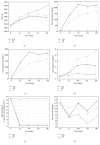Oxysterols Increase Inflammation, Lipid Marker Levels and Reflect Accelerated Endothelial Dysfunction in Experimental Animals
- PMID: 29713239
- PMCID: PMC5866902
- DOI: 10.1155/2018/2784701
Oxysterols Increase Inflammation, Lipid Marker Levels and Reflect Accelerated Endothelial Dysfunction in Experimental Animals
Abstract
Objective: Oxidized cholesterol derivatives are thought to exert atherogenic effect thus adversely affecting vascular endothelium. The aim of the study was to assess the effect of 5α,6α-epoxycholesterol on experimentally induced hypercholesterolemia in rabbits, and the levels of homocysteine (HCY), asymmetric dimethylarginine (ADMA), paraoxonase-1 (PON-1), and inflammatory parameters (IL-6, TNF-α, CRP).
Material and methods: The rabbits were divided into 3 groups, 8 animals each, and fed with basic fodder (C), basic fodder plus cholesterol (Ch) or basic fodder plus 5α,6α-epoxycholesterol, and unoxidized cholesterol (ECh). Serum concentrations of studied parameters were determined at 45-day intervals. The study was continued for six months.
Results: We demonstrated that adding 5α,6α-epoxycholesterol to basic fodder significantly affected lipid status of the experimental animals, increasing total cholesterol and LDL cholesterol levels, as well as HCY and ADMA levels, whilst leaving the PON-1 activity unaffected. Additionally, the ECh group presented with significantly higher concentrations of inflammatory biomarkers (IL-6, TNF-α, and CRP). In the Ch group, lower yet significant (as compared to the C group) changes of levels of studied parameters were observed.
Conclusion: Exposure of animals with experimentally induced hypercholesterolemia to 5α,6α-epoxycholesterol increases dyslipidaemia, endothelial dysfunction, and inflammatory response.
Figures



Similar articles
-
5α,6α-Epoxyphytosterols and 5α,6α-Epoxycholesterol Increase Nitrosative Stress and Inflammatory Cytokine Production in Rats on Low-Cholesterol Diet.Oxid Med Cell Longev. 2020 Jun 8;2020:4751803. doi: 10.1155/2020/4751803. eCollection 2020. Oxid Med Cell Longev. 2020. PMID: 32587660 Free PMC article.
-
Relationship between serum paraoxonase and homocysteine thiolactonase activity, adipokines, and asymmetric dimethyl arginine concentrations in renal transplant patients.Transplant Proc. 2013;45(10):3685-7. doi: 10.1016/j.transproceed.2013.10.003. Transplant Proc. 2013. PMID: 24314997
-
Effects of atorvastatin therapy on hypercholesterolemic rabbits with respect to oxidative stress, nitric oxide pathway and homocysteine.Life Sci. 2007 Jun 20;81(2):121-7. doi: 10.1016/j.lfs.2007.04.027. Epub 2007 May 6. Life Sci. 2007. PMID: 17532348
-
Simvastatin and asymmetric dimethylarginine-homocysteine metabolic pathways in patients with newly detected severe hypercholesterolemia.Clin Lab. 2010;56(7-8):291-302. Clin Lab. 2010. PMID: 20857893 Clinical Trial.
-
Oxysterols in the pathogenesis of major chronic diseases.Redox Biol. 2013 Jan 31;1(1):125-30. doi: 10.1016/j.redox.2012.12.001. Redox Biol. 2013. PMID: 24024145 Free PMC article. Review.
Cited by
-
27-hydroxycholesterol promotes Aβ accumulation via altering Aβ metabolism in mild cognitive impairment patients and APP/PS1 mice.Brain Pathol. 2019 Jul;29(4):558-573. doi: 10.1111/bpa.12698. Epub 2019 Jan 22. Brain Pathol. 2019. PMID: 30582229 Free PMC article.
-
Monoclonal anti-endoglin antibody TRC105 (carotuximab) prevents hypercholesterolemia and hyperglycemia-induced endothelial dysfunction in human aortic endothelial cells.Front Med (Lausanne). 2022 Sep 7;9:845918. doi: 10.3389/fmed.2022.845918. eCollection 2022. Front Med (Lausanne). 2022. PMID: 36160139 Free PMC article.
-
Novel Biomarkers of Atherosclerotic Vascular Disease-Latest Insights in the Research Field.Int J Mol Sci. 2022 Apr 30;23(9):4998. doi: 10.3390/ijms23094998. Int J Mol Sci. 2022. PMID: 35563387 Free PMC article. Review.
-
27-hydroxycholesterol causes cognitive deficits by disturbing Th17/Treg balance and the related immune responses in mild cognitive impairment patients and C57BL/6J mice.J Neuroinflammation. 2023 Dec 19;20(1):305. doi: 10.1186/s12974-023-02986-5. J Neuroinflammation. 2023. PMID: 38115100 Free PMC article.
-
5α,6α-Epoxyphytosterols and 5α,6α-Epoxycholesterol Increase Oxidative Stress in Rats on Low-Cholesterol Diet.Oxid Med Cell Longev. 2019 Nov 15;2019:1983975. doi: 10.1155/2019/1983975. eCollection 2019. Oxid Med Cell Longev. 2019. PMID: 31827670 Free PMC article.
References
MeSH terms
Substances
LinkOut - more resources
Full Text Sources
Other Literature Sources
Medical
Research Materials
Miscellaneous

